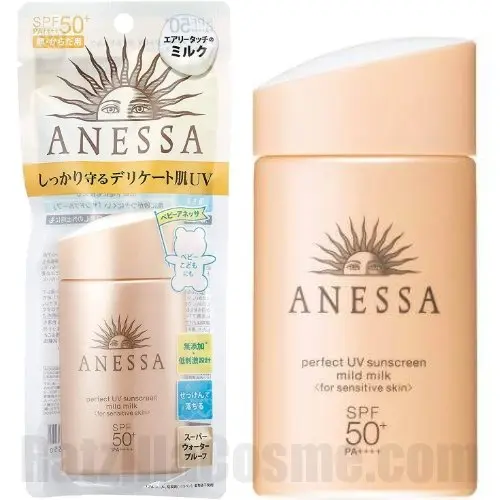- Release Date
- 2018.2.21
- Size
- 20ml / 60ml
- Brand
- ANESSA
- Producer
- Shiseido Japan Co.
- Product Type
- Sunscreen
- Price
- ¥1,200 / ¥3,000
- SPF・PA
- SPF50+·PA++++
- UV Filter(s)
- Zinc Oxide, Titanium Dioxide, Uvinul T 150, Uvinul A Plus & Tinosorb S.
The product has been replaced or discontinued as of 2020.
ANESSA Perfect UV Sunscreen Mild Milk is a Japanese sunscreen milk for sensitive skin.
The sunscreen fluid has an additive-free, extra gentle formula developed specifically for the needs of sensitive children’s and babies’ skin. It features Anessa’s signature Aqua Booster technology which reacts with the minerals in sweat and water upon contact to create a more uniform and stronger protective veil over the skin.
Ideally suited for outdoor activities and sports, the light-as-air milky fluid gives delicate skin durable protection against UV damages and irritating airborne particles. Skin feels comfortable and silky smooth. Alcohol-free, fragrance-free, paraben-free.
- For the face and body.
- Resistant to water and sweat (80 minutes).
- Can be used as a makeup base.
- Removable with face wash or soap.
Ingredient(s): Alcohol-Free Dipotassium Glycyrrhizate Fragrance-Free Octinoxate-Free Paraben-Free Tinosorb S Uvinul A Plus
Skin Type(s): Children's Skin Sensitive Skin
Beauty Concern(s): Redness & Irritation
UV Protection: Outdoor Activities & Sports PA++++
Cyclopentasiloxane,, zinc oxide,, diisopropyl sebacate,, methyl methacrylate crosspolymer,, water,, cetyl ethylhexanoate,, pentaerythrityl tetraethylhexanoate,, triethylhexanoin,, butylene glycol,, diethylhexyl succinate,, titanium dioxide,, dimethicone,, glycerin,, polymethylsilsesquioxane,, dextrin palmitate,, PEG-9 polydimethylsiloxyethyl dimethicone,, ethylhexyl triazone,, ratzillacosme.com do.not.copy,, diethylamino hydroxybenzoyl hexyl benzoate,, disteardimonium hectorite,, trimethylsiloxysilicate,, bis-ethylhexyloxyphenol methoxyphenyl triazine,, PEG/PPG-14/7 dimethyl ether,, sodium chloride,, dipotassium glycyrrhizate,, angelica acutiloba root extract,, thymus serpyllum extract,, rosa roxburghii fruit extract,, sodium hyaluronate,, PEG-10 dimethicone,, aluminum hydroxide,, stearic acid,, silica,, sodium citrate,, sodium metabisulfite,, tocopherol.
「アネッサ パーフェクトUVマイルドミルク」の全成分:シクロペンタシロキサン,酸化亜鉛,セバシン酸ジイソプロピル,メタクリル酸メチルクロスポリマー,水,エチルヘキサン酸セチル,テトラエチルヘキサン酸ペンタエリスリチル,トリエチルヘキサノイン,BG,コハク酸ジエチルヘキシル,酸化チタン,ジメチコン,グリセリン,ポリメチルシルセスキオキサン,パルミチン酸デキストリン,PEG-9ポリジメチルシロキシエチルジメチコン,エチルヘキシルトリアゾン,ジエチルアミノヒドロキシベンゾイル安息香酸ヘキシル,ジステアルジモニウムヘクトライト,トリメチルシロキシケイ酸,ビスエチルヘキシルオキシフェノールメトキシフェニルトリアジン,PEG/PPG-14/7ジメチルエーテル,塩化Na,グリチルリチン酸2K,トウキ根エキス,ワイルドタイムエキス,イザヨイバラエキス,ヒアルロン酸Na,PEG-10ジメチコン,水酸化Al,ステアリン酸,シリカ,クエン酸Na,ピロ亜硫酸Na,トコフェロール

